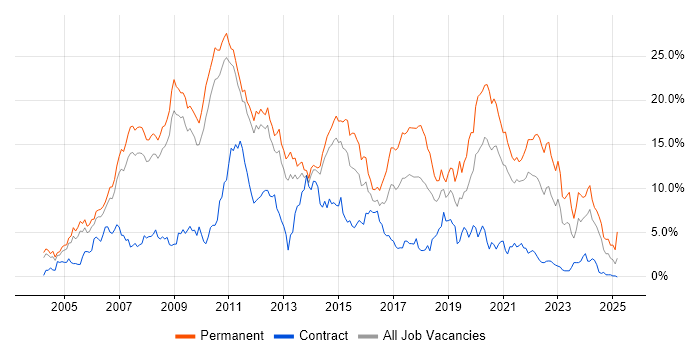C#
South Yorkshire > Sheffield
The table below provides summary statistics for permanent job vacancies advertised in Sheffield requiring C# skills. It includes a benchmarking guide to the annual salaries offered in vacancies that cited C# over the 6 months leading up to 11 July 2025, comparing them to the same period in the previous two years.
| 6 months to 11 Jul 2025 |
Same period 2024 | Same period 2023 | |
|---|---|---|---|
| Rank | 24 | 15 | 12 |
| Rank change year-on-year | -9 | -3 | -1 |
| Permanent jobs citing C# | 24 | 109 | 115 |
| As % of all permanent jobs advertised in Sheffield | 6.19% | 9.22% | 14.84% |
| As % of the Programming Languages category | 21.24% | 29.38% | 32.12% |
| Number of salaries quoted | 24 | 98 | 37 |
| 10th Percentile | £29,825 | £30,000 | £28,850 |
| 25th Percentile | £38,750 | £36,250 | £38,750 |
| Median annual salary (50th Percentile) | £60,000 | £47,500 | £52,500 |
| Median % change year-on-year | +26.32% | -9.52% | - |
| 75th Percentile | £78,813 | £58,750 | £58,750 |
| 90th Percentile | £84,250 | £65,000 | £78,750 |
| South Yorkshire median annual salary | £60,000 | £47,500 | £52,500 |
| % change year-on-year | +26.32% | -9.52% | - |
All Programming Languages
Sheffield
C# falls under the Programming Languages category. For comparison with the information above, the following table provides summary statistics for all permanent job vacancies requiring coding skills in Sheffield.
| Permanent vacancies with a requirement for coding skills | 113 | 371 | 358 |
| As % of all permanent jobs advertised in Sheffield | 29.12% | 31.39% | 46.19% |
| Number of salaries quoted | 92 | 298 | 169 |
| 10th Percentile | £26,475 | £29,750 | £26,250 |
| 25th Percentile | £32,500 | £36,250 | £35,000 |
| Median annual salary (50th Percentile) | £46,000 | £50,000 | £49,045 |
| Median % change year-on-year | -8.00% | +1.95% | -6.58% |
| 75th Percentile | £65,313 | £62,500 | £60,000 |
| 90th Percentile | £82,500 | £75,772 | £70,000 |
| South Yorkshire median annual salary | £50,000 | £47,500 | £47,500 |
| % change year-on-year | +5.26% | - | -5.00% |
C#
Job Vacancy Trend in Sheffield
Job postings citing C# as a proportion of all IT jobs advertised in Sheffield.

C#
Salary Trend in Sheffield
3-month moving average salary quoted in jobs citing C# in Sheffield.
C#
Salary Histogram in Sheffield
Salary distribution for jobs citing C# in Sheffield over the 6 months to 11 July 2025.
C#
Co-occurring Skills and Capabilities in Sheffield by Category
The follow tables expand on the table above by listing co-occurrences grouped by category. The same employment type, locality and period is covered with up to 20 co-occurrences shown in each of the following categories:
